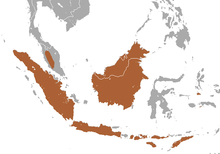| Sunda shrew | |
|---|---|

| |
| Conservation status | |
 Least Concern (IUCN 3.1) | |
| Scientific classification | |
| Domain: | Eukaryota |
| Kingdom: | Animalia |
| Phylum: | Chordata |
| Class: | Mammalia |
| Order: | Eulipotyphla |
| Family: | Soricidae |
| Genus: | Crocidura |
| Species: | C. monticola |
| Binomial name | |
| Crocidura monticola Peters, 1870 | |

| |
| Sunda shrew range | |
The Sunda shrew (Crocidura monticola) is a species of mammal in the family Soricidae found in Indonesia and Malaysia.
Populations from the Malay Peninsula, Sumatra and Borneo are now considered to belong to Crocidura neglecta. The widespread species C. neglecta sensu lato, exhibits high levels of diversity. The divergence among populations from Peninsular Malaysia, west Borneo and north-east Borneo is higher than that among many other recognised related species, suggesting that these might deserve specific status. Species delimitation based on private allele sharing also supports the species-level recognition of these populations and perhaps also that of the Bukit Baka [ceb] population. However, these have not been described due to lack of morphological evidence and the small number of localities included in species delimitation analyses. An increase in specimen collection and geographic coverage is needed to characterize the fine-scale distribution of this diversity and resolve the taxonomy of this group.
It is found in the forest floor of the rainforest. It is an omnivore and feeds mostly on plants and leaves that fall from the emergent and the canopy layers. It is 25 cm (9.8 in) long and weighs less than 8 g (0.28 oz).
References
- ^ Chiozza, F. (2016). "Crocidura monticola". IUCN Red List of Threatened Species. 2016: e.T41337A22306541. doi:10.2305/IUCN.UK.2016-2.RLTS.T41337A22306541.en. Retrieved 14 November 2021.
- Demos, Terrence; Achmadi, Anang Setiawan; Giarla, Thomas C.; Handika, Heru; Rowe, Kevin; Esselstyn, Jacob A. (23 August 2016). "Local endemism and within-island diversification of shrews illustrate the importance of speciation in building Sundaland mammal diversity". Molecular Ecology. 25 (20): 5158–5173. Bibcode:2016MolEc..25.5158D. doi:10.1111/mec.13820. PMID 27552382.
- Hinckley, Arlo; Camacho-Sanchez, Miguel; Ruedi, Manuel; Hawkins, Melissa T.R.; Mullon, Madeleine; Cornellas, Anna; Tuh Yit Yuh, Fred; Leonard, Jennifer A. (24 July 2021). "Evolutionary history of Sundaland shrews (Eulipotyphla: Soricidae: Crocidura) with a focus on Borneo". Zoological Journal of the Linnean Society. 194 (2): 478–501. doi:10.1093/zoolinnean/zlab045. hdl:10261/362606.
| Taxon identifiers | |
|---|---|
| Crocidura monticola | |
This article about a white-toothed shrew is a stub. You can help Misplaced Pages by expanding it. |